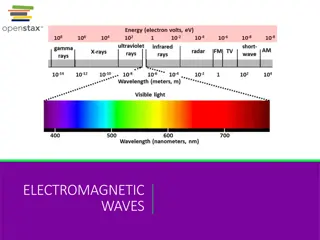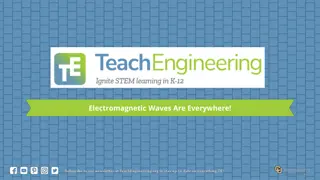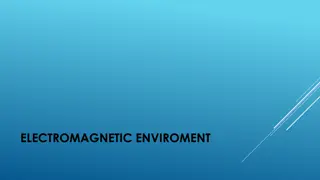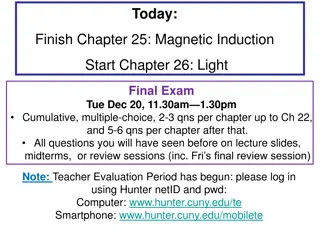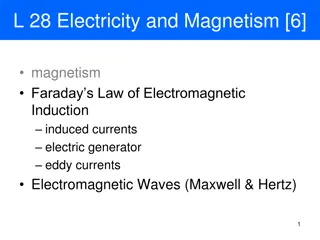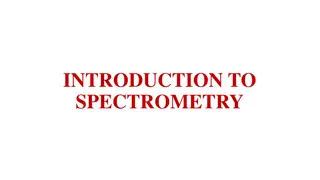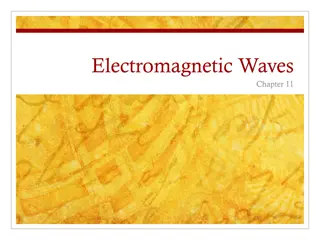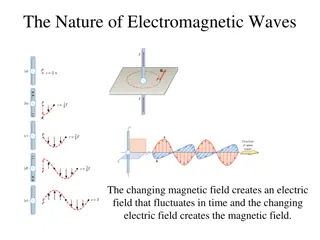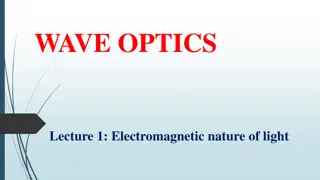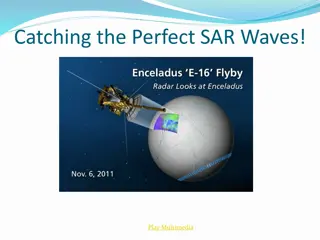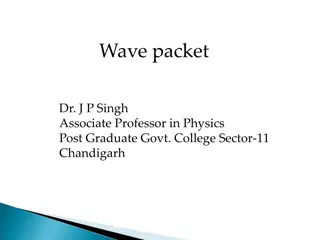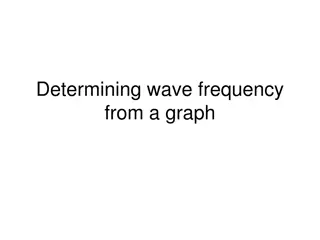Understanding Electromagnetic Induction and Wave Characteristics
Explore the concept of electromagnetic induction, its explanation by scientists, and the presence of a black strip on your debit card. Discover the basic characteristics of waves, including amplitude, crest, trough, wavelength, phase, frequency, and speed. Dive into the world of waves and their energy-carrying properties through matter or space.
Download Presentation

Please find below an Image/Link to download the presentation.
The content on the website is provided AS IS for your information and personal use only. It may not be sold, licensed, or shared on other websites without obtaining consent from the author. Download presentation by click this link. If you encounter any issues during the download, it is possible that the publisher has removed the file from their server.
E N D
Presentation Transcript
Bellringer What is electromagnetic induction and who explained it? Why does your debit card have a black strip on the back?
Updates SLC today E&M Quiz 10 questions 3 MC, 6 written, 1 drawing Scientists Electromagnetic Induction, Electromotive force Magnetic field lines Electric motors/generators Transformers, solenoids, railgun, speakers, etc.
Objectives Learn the basic characteristics of waves and use them to solve simple problems.
What Are Waves? A wave is a disturbance that carries energy through matter or space without transferring matter. Wave Demo
Wave Characteristics Amplitude: The greatest distance from equilibrium. The bigger the amplitude of the wave, the more energy the wave has.
Wave Characteristics Crest: The top point of a wave. Trough: The bottom point of a wave.
Wave Characteristics Wavelength: The shortest distance between points where the wave pattern repeats itself. Wavelength is measured in meters, the symbol is ?
Wave Characteristics Phase: Any two points on a wave that are one or more whole wavelengths apart are said to be in phase .
Wave Characteristics Frequency: Is the number of complete oscillations a point on that wave makes each second. Frequency is measured in Hertz (Hz), its units are 1 ?
Wave Characteristics Speed: The speed or velocity of a wave is how fast the energy is moved. For most waves, wave speed does not depend on amplitude, frequency, or wavelength. Speed depends only on the medium through which it moves. ? =? ? ? = ? ,? =1 ? ? = ??
Wave Characteristics Period: The time it takes a wave to go through one cycle, or the time it takes a point to go through one phase of the wave. The period of a wave is measured in seconds, and it s symbol is T . ? =1 ?
Example What is the velocity of a wave that has a frequency of 250Hz and a wavelength of 1.5m? ? = ?? ? = 250?? 1.5? = 375? ?
Checkpoint How does the speed of a wave change if the amplitude is increased? The speed doesn t change. What is the velocity of a wave that has a frequency of 100Hz and a wavelength of 2.0m? ? = ?? ? = 100?? 2.0? = 200? ?
Practice On page 393 of the textbook answer questions 15, 16, 17, 19, 22, and 24.
Answers 15. 343m/s, 2.29x10^-3s, 0.787m 16. You should shake it at a lower frequency because wavelength varies inversely with frequency. 17. 2.45m/s 19. 2.50m 22. The frequency is one-half of its original value. 24. The wavelength increases to 1.5 times its original value.
Bellringer What does a wave transfer? DO WORK STOP Energy, NOT MASS!
Objectives Review and solidify the material you learned and practiced yesterday. Learn about the different types of waves. Study, create, and destroy different wave types.
Practice On page 393 of the textbook answer questions 15, 16, 17, 19, 22, and 24.
Answers 15. 343m/s, 2.29x10^-3s, 0.787m 16. You should shake it at a lower frequency because wavelength varies inversely with frequency. 17. 2.45m/s 19. 2.50m 22. The frequency is one-half of its original value. 24. The wavelength increases to 1.5 times its original value.
Art Time Example Part Two Draw two more cycles of the red wave.
Art Time Example Part Two Draw one more cycles of the blue wave.
Art Time Example Part Two What is the wavelength of the red wave? 2.0m
Art Time Example Part Two What is the wavelength of the blue wave? 4.0m
Art Time Example Part Two What is the amplitude of the red wave? 0.5m
Art Time Example Part Two What is the amplitude of the blue wave? 0.25m
Art Time Example Part Two If this is a snapshot of how far each wave traveled in 1 second, what is the frequency of the red wave? 3.0Hz
Art Time Example Part Two If this is a snapshot of how far each wave traveled in 1 second, what is the frequency of the blue wave? 1.5Hz
Art Time Example Part Two Are the red and blue wave in phase with each other? Nope
Art Time Example Part Two Mark two spots on each wave that are in phase with each other.
You try Draw the following waves on the same graph: 1. A wave with an amplitude of 6m and a wavelength of 3m. 2. A wave with an amplitude of 2m and a wavelength of 2m. 3. A wave with an amplitude of 3m and a wavelength of 4m. Which wave has the greatest frequency if they re all traveling at the same speed?
Types of Waves There are two types of waves! Transverse Waves: A wave that disturbs the particles in the medium perpendicular to the direction of the wave s travel. 2. Longitudinal Waves: A wave that disturbs the particles in the medium parallel to the direction of the wave s travel. 1.
Checkpoint What is a Transverse wave? 1. 2. What is a Longitudinal wave?
Slinky Demo How can a single transverse wave pulse be produced using a slinky? How can a single longitudinal wave pulse be produced using a slinky? Sound waves are longitudinal waves because they shake the air as they transfer the energy to our ears.
Must Watch Television https://www.youtube.com/watch?v=XFF2ECZ8m1A
Bellringer What is the speed of a radio wave that has wavelength of 1,396m and a frequency of 214,899.7135Hz? ? = ?? ? = 214,899.7135?? (1,396?) ? = 300,000,000? DO WORK STOP ?
Objectives Learn about the different types of waves. Study, create, and destroy different wave types.
Grade Update Answer these questions. How did you follow your plan on how to improve your grade? 2. Are you happy with your grade and what do you want your grade to be by the end of the quarter? 3. What are you going to do to improve your grade? 1.
Waves at Boundaries What does the surface of water look like when you drop a small rock in a calm bucket of water? What happens when the wave hits the walls? Splash Demo!!! Get your goggles!
Waves at Boundaries Recall that a wave s speed depends on the medium it passes through: Water depth Air temperature Tension, and mass A Boundary is when a wave goes from one medium to another.
Waves at Boundaries There are three ways you ll be interested in at boundaries. 1. Incident Wave: A wave pulse that strikes the boundary. 2. Reflected Wave: A wave that bounces backwards after hitting the boundary. 3. Transmitted Wave: A wave that continue forward after hitting the boundary.
Waves at Boundaries Demos Different Medium Demo: The incident energy is split between reflected and transmitted energy. Rigid Boundaries Demo: All of the incident energy is turned into reflected energy.
Checkpoint How does the amplitude (energy) of a wave change when it hits a rigid boundary like a wall? 1. 2. How is the conservation of energy observable with a single wave hitting a different medium?
Waves in a Bucket What happens if you drop two rocks into a calm bucket of water instead of just one? Splash Demo 2.0!!! Get dem goggles back! The waves seem to hit each other, but then just continue on their way weird?
Wave Interference When we had two particles (carts) and pushed them into each other they collided and then stopped. When waves collide they temporarily interfere with one another, but they do not stop each other.




